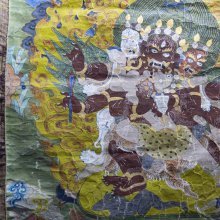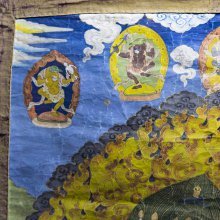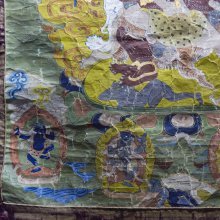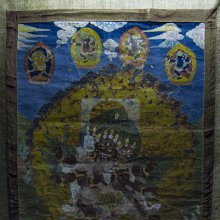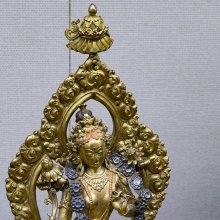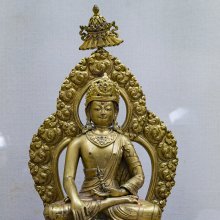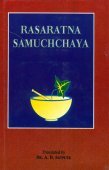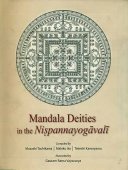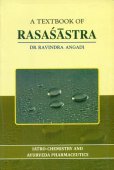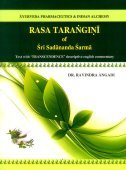Ratna, Ratnā: 38 definitions
Introduction:
Ratna means something in Buddhism, Pali, Hinduism, Sanskrit, Jainism, Prakrit, the history of ancient India, Marathi, Hindi. If you want to know the exact meaning, history, etymology or English translation of this term then check out the descriptions on this page. Add your comment or reference to a book if you want to contribute to this summary article.
Alternative spellings of this word include Ratn.
Images (photo gallery)
(+6 more images available)
In Hinduism
Ayurveda (science of life)
Rasashastra (Alchemy and Herbo-Mineral preparations)
Source: Wisdom Library: Rasa-śāstraRatna (रत्न):—There are nine types of gems, according to the Rasaprakāśasudhākara, which is a 13th century Sanskrit literary work related to Medical Alchemy, or Rasaśāstra (Rasa literature).
- Māṇikya (‘Ruby’),
- Mauktika (‘Pearl’),
- Vidruma or Pravāla (‘Coral’),
- Tārkṣya (‘Emerald’),
- Puṣparāga or Puṣpaka (‘Topaz’),
- Vajra (‘Diamond’),
- Nīla or Nīlamaṇi (‘Sapphire’),
- Gomeda (‘Hessonite’),
- Vaidūrya (‘Cat’s eye’)
The ratnas of superior quality and possessing better physical characteristics may only prove to give all types of siddhis (success). And only such ratnas (gemstones) should be used for dāna (offering purpose), rasa-yana (therapeutic purpose), dhāraṇa bearing purpose and devatārcana (worship of Gods).
Unclassified Ayurveda definitions
Source: gurumukhi.ru: Ayurveda glossary of termsRatna (रत्न):—Precious Stones

Āyurveda (आयुर्वेद, ayurveda) is a branch of Indian science dealing with medicine, herbalism, taxology, anatomy, surgery, alchemy and related topics. Traditional practice of Āyurveda in ancient India dates back to at least the first millenium BC. Literature is commonly written in Sanskrit using various poetic metres.
Shaivism (Shaiva philosophy)
Source: Wisdom Library: Kubjikāmata-tantraRatnā (रत्ना, “Jewel”):—Fifth of the eight Mātṛs born from the body of Śaśinī, according to the Kubjikāmata-tantra. These eight sub-manifestations (mātṛ), including Ratnā, symbolize a connection to the moon. They are presided over by the Bhairava Krodha and his consort Vaiṣṇavī. Śaśinī is the third of the Eight Mahāmātṛs, residing within the Mātṛcakra (third of the five cakras) and represents the moon.
Source: Brill: Śaivism and the Tantric TraditionsRatna (रत्न) refers to “jewels”, according to the Halāyudhastotra verse 34-35.—Accordingly, “The visitation of the wives of the distinguished sages in the Pine Park, the oblation with seed in Fire, the twilight dance: Your behaviour is not reprehensible. O Three-eyed one! The doctrines of the world do not touch those who have left worldly life, having passed far beyond the path of those whose minds are afflicted by false knowledge. The gods all wear gold and jewels (heman-ratna) as an ornament on their body. You do not even wear gold the size of a berry on your ear or on your hand. The one whose natural beauty, surpassing the path [of the world], flashes on his own body, has no regard for the extraneous ornaments of ordinary men”.

Shaiva (शैव, śaiva) or Shaivism (śaivism) represents a tradition of Hinduism worshiping Shiva as the supreme being. Closely related to Shaktism, Shaiva literature includes a range of scriptures, including Tantras, while the root of this tradition may be traced back to the ancient Vedas.
Purana and Itihasa (epic history)
Source: archive.org: Shiva Purana - English Translation1) Ratna (रत्न) refers to “gems”, representing a type of material for construction of a Liṅga, according to the Śivapurāṇa 1.22 while explaining the importance of the partaking of the Naivedya of Śiva:—“[...] with regard to the following phallic images viz:—[...] liṅgas made of gems (Ratna-liṅga) [...], the partaking of the Naivedya of Śiva is on a par with the rite of Cāndrāyaṇa. Even the slayer of a brahmin if he partakes of the remains of the food offered to the God quells all his sins immediately [...]”.
2) Ratna (रत्न) refers to “precious gems”, representing the material of the Brahmāṇī’s liṅga, according to the Śivapurāṇa 2.1.12, where the Devas and Viṣṇu requested Viśvakarman for liṅgas for the achievement of the desires of all people:—“[...] at our bidding Viśvakarmā made liṅgas and gave them to the devas according to their status. [...] the Goddess Brahmāṇī worships, of course, the Liṅga of Ratna (precious gem) [viz., Ratna-liṅga]. Bāṇa and others worshipped a liṅga of mercury. [...] Thus different kinds of liṅgas were given to them by Viśvakarmā which the devas and the celestial sages worship regularly. After giving the devas the various liṅgas from a desire for their benefit, Viṣṇu explained the mode of worship of Śiva to me, Brahmā”.
Source: Cologne Digital Sanskrit Dictionaries: The Purana IndexRatnā (रत्ना).—A daughter of Śaibya, queen of Akrūra and mother of eleven heroic sons.*
- * Matsya-purāṇa 45. 28.

The Purana (पुराण, purāṇas) refers to Sanskrit literature preserving ancient India’s vast cultural history, including historical legends, religious ceremonies, various arts and sciences. The eighteen mahapuranas total over 400,000 shlokas (metrical couplets) and date to at least several centuries BCE.
Shilpashastra (iconography)
Source: Shodhganga: The significance of the mūla-beras (śilpa)Ratna (रत्न) refers to “ruby” and represents a kind of precious stone (gem) used for the making of images (Hindu icons), as defined in the texts dealing with śilpa (arts and crafs), known as śilpaśāstras.—The materials listed in the Āgamas for the making of images are wood, stone, precious gems, metals, terracotta, laterite, earth, and a combination of two or three or more of the materials specified above. The precious stones mentioned in the Āgamas for the purpose of making images are [for example] ratna (ruby).
Precious stones (e.g., ratna or ‘ruby’) are preferred materials for fashioning images.—The materials recommended in the śilpaśāstra for the fashioning of images are unburnt clay, burnt clay as in brick or terracotta, sudhā (a special kind of mortar/plaster), composite earth, wood, stone, metal, ivory, dhātu (mineral), pigment, and precious stones. Wood is considered superior to earth, stone as better than wood, metal better than stone, and precious stone (such as ratna) is the most preferred of all.

Shilpashastra (शिल्पशास्त्र, śilpaśāstra) represents the ancient Indian science (shastra) of creative arts (shilpa) such as sculpture, iconography and painting. Closely related to Vastushastra (architecture), they often share the same literature.
Jyotisha (astronomy and astrology)
Source: Wisdom Library: Brihat Samhita by VarahamihiraRatna (रत्न) refers to “precious stones”, according to the Bṛhatsaṃhitā (chapter 15) (“On the nakṣatras—‘asterisms’”), an encyclopedic Sanskrit work written by Varāhamihira mainly focusing on the science of ancient Indian astronomy astronomy (Jyotiṣa).—Accordingly, “[...] Those who are born on the lunar day of Mṛgaśirṣa will delight or deal in perfumes, dress, pearls, flowers, fruits, precious stones (ratna), wild beasts, birds and deer; will be Somayajis or singers; will be lascivious; will be good writers or painters. Those who are born on the lunar day of Ārdrā will delight in killing, torturing, lying, in adultery, thieving, cheating and tale-bearing; will deal in pod-grains, black magic, sorcery and exorcism. [...]”.
Source: Google Books: Studies in the History of the Exact Sciences (Astronomy)Ratna (रत्न) refers to “jewels”, according to Govinda Daivajña’s Pīyūṣadhārā (verse p.424), a commentary on Rāma Daivajña’s Muhūrtacintāmaṇi (AD 1600).—Accordingly, “[...] After having seen the rise of half of the Sun’s orb, or the setting of the half likewise, the instrument having the aforementioned characteristics should be deposited, with this sacred formula.—{‘Should be deposited’ means ‘in a basin filled with water’. Thus spoke Nārada: In a copper basin, which is filled with water, which is decorated with sandal paste and flowers, which is situated upon grains of rice on a pure ground, and which is endowed with jewels (ratna-yuta), after noticing the rise of half of the Sun’s orb, [the bowl] should be deposited. He also taught the sacred formula.}—[...]”.

Jyotisha (ज्योतिष, jyotiṣa or jyotish) refers to ‘astronomy’ or “Vedic astrology” and represents the fifth of the six Vedangas (additional sciences to be studied along with the Vedas). Jyotisha concerns itself with the study and prediction of the movements of celestial bodies, in order to calculate the auspicious time for rituals and ceremonies.
Shaktism (Shakta philosophy)
Source: Google Books: ManthanabhairavatantramRatnā (रत्ना) is the name of the Cave (guhā) associated with the sacred seat of Jālandhara (jālapītha), according to the Manthānabhairavatantra, a vast sprawling work that belongs to a corpus of Tantric texts concerned with the worship of the goddess Kubjikā.—Accordingly, “The sacred seat Jāla is the Unmanifest. It is well placed in the southern quarter. It is black and called the most excellent. The mother (avvā) is the venerable lioness Kālikā. It bestows the boon of the mantra of nine (letters i.e. Navātman). The tree is called Bilva. The cave is called Ratnā; it contains the best Rule and is well known by the name 'Vīra'. The cremation ground is called Laguḍa. [...]”.

Shakta (शाक्त, śākta) or Shaktism (śāktism) represents a tradition of Hinduism where the Goddess (Devi) is revered and worshipped. Shakta literature includes a range of scriptures, including various Agamas and Tantras, although its roots may be traced back to the Vedas.
Vastushastra (architecture)
Source: Brill: Śaivism and the Tantric Traditions (architecture)Ratna (रत्न) refers to “gems”, according to the Devyāmata (chapter 105).—Accordingly, [while describing the layout of the residence (gṛha) for the prāsādāśramin]—“[...] Storage for gems (ratna), gold and cloths is recommended in the east, and for water in the south and centre. Grain storage is recommended in the west. In the northwest is storage for the mortar. [...]”.

Vastushastra (वास्तुशास्त्र, vāstuśāstra) refers to the ancient Indian science (shastra) of architecture (vastu), dealing with topics such architecture, sculpture, town-building, fort building and various other constructions. Vastu also deals with the philosophy of the architectural relation with the cosmic universe.
Ganitashastra (Mathematics and Algebra)
Source: archive.org: Hindu MathematicsRatna (रत्न) represents the number 3 (three) in the “word-numeral system” (bhūtasaṃkhyā), which was used in Sanskrit texts dealing with astronomy, mathematics, metrics, as well as in the dates of inscriptions and manuscripts in ancient Indian literature.—A system of expressing numbers by means of words arranged as in the place-value notation was developed and perfected in India in the early centuries of the Christian era. In this system the numerals [e.g., 3—ratna] are expressed by names of things, beings or concepts, which, naturally or in accordance with the teaching of the Śāstras, connote numbers.
Note: Ratna is used by Mahāvīra only; others take it for five.

Ganitashastra (शिल्पशास्त्र, gaṇitaśāstra) refers to the ancient Indian science of mathematics, algebra, number theory, arithmetic, etc. Closely allied with astronomy, both were commonly taught and studied in universities, even since the 1st millennium BCE. Ganita-shastra also includes ritualistic math-books such as the Shulba-sutras.
Kama-shastra (the science of Love-making)
Source: Shodhganga: Elements of Art and Architecture in the Trtiyakhanda of the Visnudharmottarapurana (kama)Ratna (रत्न) refers to the “precious stones”.—Cf. Rūpyaratnaparīkṣā which refers to “knowledge about precious metals and stones”, representing one of the “sixty four kinds of Art”, according to the Kāmasūtra of Vātsyāyaṇa.—Indian tradition, basically includes sixty four Art forms are acknowledged. The references of sixty four kinds of kalā are found in the Bhāgavatapurāṇa, Śaiva-Tantras, Kāmasūtra of Vātsyāyaṇa etc.
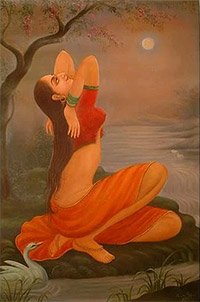
Kamashastra (कामशास्त्र, kāmaśāstra) deals with ancient Indian science of love-making, passion, emotions and other related topics dealing with the pleasures of the senses.
General definition (in Hinduism)
Source: archive.org: Vedic index of Names and SubjectsRatna (रत्न) in the Rigveda and later denotes a precious object, not specifically a ‘jewel’, as in post-Vedic literature.
In Buddhism
Mahayana (major branch of Buddhism)
Source: Wisdom Library: Maha Prajnaparamita SastraRatna (रत्न) refers to jewels, into which the universe was transformed by the Buddha’s miraculous power (ṛddhibala) according to the 2nd century Mahāprajñāpāramitāśāstra (chapter XV).
There are four types of jewels:
- Kin (suvarṇa), gold;
- Yin (rajata, rūpya), silver;
- P’i lieou li (vaiḍūrya), lapis-lazuli;
- P’o li (sphaṭika), crystal.
- Tch’ö k’iu (musāragalva) cat’s-eye;
- Ma nao (aśmagarbha) emerald;
- Tch’e tchen tchou (lohitamukti), red pearl.
There are yet other jewels:
- Mo lo k’ie t’o (marakata), emerald;
- Yin t’o ni lo (indranīla), sapphire;
- Mo ho ni lo (mahānīla) ‘great blue’ pearl;
- Po mo lo k’ie (padmarāga), ruby;
- Yue chö (vajra) diamond;
- Long tchou (nāgamaṇi), nāga pearl;
- Jou yi tchou (cintāmaṇi), precious stone that grants all the wishes of its owner;
- Yu, jade;
- Pei (śaṅkha) conch;
- Chan hou (pravāḍa, vidruma), coral;
- Hou p’e (tṛṇamaṇi) amber, etc.
All these are called jewel (ratna). These jewels are of three types, Human jewels (manuṣya-ratna), Divine jewels (divya-ratna) and Bodhisattva jewels (bodhisattva-ratna). These various jewels remove the poverty (dāridrya) and the suffering (duḥkha) of beings.

Mahayana (महायान, mahāyāna) is a major branch of Buddhism focusing on the path of a Bodhisattva (spiritual aspirants/ enlightened beings). Extant literature is vast and primarely composed in the Sanskrit language. There are many sūtras of which some of the earliest are the various Prajñāpāramitā sūtras.
Tibetan Buddhism (Vajrayana or tantric Buddhism)
Source: Wisdom Library: Tibetan BuddhismRatnā (रत्ना) is the name of a Dhāraṇī Goddesses mentioned as attending the teachings in the 6th century Mañjuśrīmūlakalpa: one of the largest Kriyā Tantras devoted to Mañjuśrī (the Bodhisattva of wisdom) representing an encyclopedia of knowledge primarily concerned with ritualistic elements in Buddhism. The teachings in this text originate from Mañjuśrī and were taught to and by Buddha Śākyamuni in the presence of a large audience (including Ratnā).
Source: archive.org: The Indian Buddhist IconographyRatna (रत्न) refers to “jewels” and represents one of the five auspicious symbols of Nairātmā.—The Indian Museum image is the only image of this goddess [Nairātmā] which conforms to the description given in the sādhana. Here the goddess, in accordance with the Dhyāna, has a terrible appearance with canine teeth, garland of heads and three eyes rolling in anger. She stands on the corpse lying on its back, and dances in the ardhaparyaṅka attitude. Burning flames radiate from her person, and her hair rise upwards in the shape of a flame. She is decked in the five auspicious symbols, the kaṇṭhikā (torque), rucaka (bracelets), ratna (jewels), mekhalā (girdle), and bhasma (ashes) or the sūtra (sacred thread) in the form of a garland of heads. She bears the image of her sire Akṣobhya on her crown and carries the menacing kartri in the right hand. The left hand holding the kapāla is broken. The khaṭvāṅga, as usual, hangs from her left shoulder.
Source: Brill: Śaivism and the Tantric Traditions (tantric Buddhism)Ratna (रत्न) refers to “jewels” (offerings), according to the Bhūśalyasūtrapātananimittavidhi section of Jagaddarpaṇa’s Ācāryakriyāsamuccaya, a text within Tantric Buddhism dealing with construction manual for monasteries etc.—Accordingly, “[...] Having praised [the cord] with the sounds of a bell, auspicious song, conch shell, and bamboo flute, the donor should offer guest water [to the cord] together with jewels (ratna), gold, and fragrant flowers, which are blooming and beautiful, and mixed with the juice extracted from the sprouts of the airandhrīkara”.

Tibetan Buddhism includes schools such as Nyingma, Kadampa, Kagyu and Gelug. Their primary canon of literature is divided in two broad categories: The Kangyur, which consists of Buddha’s words, and the Tengyur, which includes commentaries from various sources. Esotericism and tantra techniques (vajrayāna) are collected indepently.
In Jainism
General definition (in Jainism)
Source: Google Books: Jainism: An Indian Religion of SalvationRatna (रत्न).—The fourteen gems (ratna) are the living beings of different types which serve the Cakravartīs. They are divided into those which are provided only with one sense (ekendriya-ratna) and those which have five senses (pañcendriya-ratna).
The seven gems with one sense (ekendriya-ratna) are:
- cakra, a discues embellished with jewels;
- daṇḍa, a spledid staff with which the earth can be bored into its depths;
- khaḍga, a sharp sword which breaks all resistance;
- chatra, a glittering white sun-umbrella;
- carma, a wonderful hide which cannot be pierced by cut and thrust;
- maṇi, a gem of uncomparable dazzle;
- kākiṇī, a sort of very gollow mass in the form of a dice;
The seven gems with five senses (pañcendriya-ratna) are:
- senāpati, the commander of a Cakravartī;
- gṛhapati, chamberlain who looks after the kitchen and storeroom;
- vārddhaka, architect;
- purohita, house-priest;
- gaja, elephant of unsurpassable power;
- aśva, beautiful horse;
- strī, a most beautiful woman;
Ratna (रत्न).—According to both Digambara and Śvetāmbara, every universal monarch obtains ratnas or jewels amongst human beings and amongst symbols, weapons or animals. They are: cakra (disc), daṇḍa (staff), asi (sword), chatra (umbrella), carma (hides), maṇi (diamond), kākiṇī (cowrie), aśva (the horse), gaja (the elephant), the commander-in-chief, the home minister, the architect (varddhakī), the priest and lastly the Queen. Ratnas or jewels of a Cakravartī (Cakravartin) are usually represented in miniature paintings of the Saṃgrahaṇī-sūtra.
Source: archive.org: TrisastisalakapurusacaritraRatnā (रत्ना) refers to one of the 32 mountains between the lotus-lakes situated near the four Añjana mountains, which are situated in the “middle world” (madhyaloka), according to chapter 2.3 [ajitanātha-caritra] of Hemacandra’s 11th century Triṣaṣṭiśalākāpuruṣacaritra: an ancient Sanskrit epic poem narrating the history and legends of sixty-three illustrious persons in Jainism.
Accordingly:—“In the four directions from each of the Añjana Mountains there are lotus-lakes, 100,000 yojanas square: [...]. Between each two lotus-lakes there are 2 Ratikara Mountains so there are 32 Ratikara Mountains (e.g., Ratnā). On the Dadhimukha Mountains and on the Ratikara Mountains, there are eternal shrines of the Arhats, just as on the Añjana Mountains likewise at the intermediate points of the continent there are 4 Ratikara Mountains, having a length and width of 10,000 yojanas, and a height of 1,000 yojanas, made of all kinds of jewels, divine, the shape of a jhallarī. [...] In them (i.e., the 32 Ratikara Mountains, e.g., Ratnā) the gods with all their splendor together with their retinues make eight-day festivals in the shrines on the holy days of the holy Arhats”.
Source: The University of Sydney: A study of the Twelve ReflectionsRatna (रत्न) refers to a “jewels”, according to Pūjyapāda’s Sarvārthasiddhi.—Accordingly, “[...] And even among the five-sensed beings, many belong to the animal world such as the cow, the deer, the bird, the serpent, etc. Hence human birth is as difficult of attainment as a heap of jewels (ratna-rāśi) at the crossing of the roads. And if one loses the condition of a human being by negligence, it is as difficult to attain it once again, as it is difficult for a burnt tree to regain its old freshness. Even if human birth is attained, a good country, a good family, keen senses, health, etc. are more and more difficult of attainment. [...]”.

Jainism is an Indian religion of Dharma whose doctrine revolves around harmlessness (ahimsa) towards every living being. The two major branches (Digambara and Svetambara) of Jainism stimulate self-control (or, shramana, ‘self-reliance’) and spiritual development through a path of peace for the soul to progess to the ultimate goal.
India history and geography
Source: Project Gutenberg: Castes and Tribes of Southern India, Volume 1Ratna (“precious stones”) is one of the exogamous septs (divisions) among the Kurubas (a tribe of South India). The Kurubas are sub-divided into clans or gumpus, each having a headman or guru called a gaudu, who gives his name to the clan. And the clans are again sub-divided into gotras or septs (viz., Ratna).
Source: Cologne Digital Sanskrit Dictionaries: Indian Epigraphical GlossaryRatna.—(IE 7-1-2), ‘five’; sometimes also used to indicate ‘nine’, and rarely even ‘fourteen’. (EI 22; CII 4), same as the Buddhist tri-ratna, i. e. the Buddha, Dharma and Saṅgha. (ML), a relic [of the Buddha]. Note: ratna is defined in the “Indian epigraphical glossary” as it can be found on ancient inscriptions commonly written in Sanskrit, Prakrit or Dravidian languages.

The history of India traces the identification of countries, villages, towns and other regions of India, as well as mythology, zoology, royal dynasties, rulers, tribes, local festivities and traditions and regional languages. Ancient India enjoyed religious freedom and encourages the path of Dharma, a concept common to Buddhism, Hinduism, and Jainism.
Languages of India and abroad
Marathi-English dictionary
Source: DDSA: The Molesworth Marathi and English Dictionaryratna (रत्न).—n (S) A gem, a jewel, a precious stone. 2 A common term for the fourteen precious things produced by the ocean when it was churned by the gods and giants. See caudā ratnēṃ. 3 fig. A term of praise for an excellent thing in general, a jewel. 4 A cant name for a bug.
Source: DDSA: The Aryabhusan school dictionary, Marathi-Englishratna (रत्न).—n A gem. Fig. A jewel.
Marathi is an Indo-European language having over 70 million native speakers people in (predominantly) Maharashtra India. Marathi, like many other Indo-Aryan languages, evolved from early forms of Prakrit, which itself is a subset of Sanskrit, one of the most ancient languages of the world.
Sanskrit dictionary
Source: DDSA: The practical Sanskrit-English dictionaryRatna (रत्न).—[ramate'tra ram-na tāntādeśaḥ Uṇādi-sūtra 3.14]
1) A gem, jewel, a precious stone; किं रत्नमच्छा मतिः (kiṃ ratnamacchā matiḥ) Bv.1.86; न रत्नमन्विष्यति मृग्यते हि तत् (na ratnamanviṣyati mṛgyate hi tat) Kumārasambhava 5.45. (The ratnas are said to be either five, nine or fourteen; see the words pañcaratna, navaratna, and caturdaśaratna respectively.)
2) Anything valuable or precious, any dear treasure.
3) Anything best or excellent of its kind; (mostly at the end of comp.); जातौ जातौ यदुत्कृष्टं तद् रत्नमभिधीयते (jātau jātau yadutkṛṣṭaṃ tad ratnamabhidhīyate) Malli; कन्यारत्नमयोनिजन्म भवतामास्ते वयं चार्थिनः (kanyāratnamayonijanma bhavatāmāste vayaṃ cārthinaḥ) Mv.1.3; अग्रेसरीभवतु काञ्चनचक्ररत्नम् (agresarībhavatu kāñcanacakraratnam) Nāg.5.37; so पुत्र°, स्त्री° (putra°, strī°) V.4.25; अपत्य° (apatya°) &c.
4) A magnet.
5) Water.
Derivable forms: ratnam (रत्नम्).
Source: Cologne Digital Sanskrit Dictionaries: Edgerton Buddhist Hybrid Sanskrit DictionaryRatna (रत्न).—(or MIndic ratana), nt. (m. forms, see § 6.10), jewel, gem, as in Sanskrit; (1) three (Buddha, dharma, saṃgha, as in Pali): Dharmasaṃgraha 1, etc.; see triratna, ratna-traya; (2) seven precious substances, or their respective colors, suvarṇa, rūpya, muktā, vaiḍūrya, sphaṭika (or sphā°), musāragalva (or variants, see s.v.), lohitikā: Mahāvastu i.49.10 —11; 63.1; 194.5, 19; 195.9; 249.6; iii.226.10; 227.6; 323.16; a different list of seven, muktāmaṇi, vaiḍūrya, śaṅkhaśilā, pravāla, sphaṭika, musāragalva, lohitikā, Mahāvastu ii.472.1; the usual list in other texts is nearly like Mahāvastu i.49.10 etc., but omits muktā, and for Nos. 5—7 (6 and 7 of Mahāvastu) has lohitamukti, aśmagarbha, musāragalva: Saddharmapuṇḍarīka 151.1; 153.3; Divyāvadāna 297.23 ff.; Gaṇḍavyūha 52.15; 161.16; in Saddharmapuṇḍarīka 239.7 sphaṭika is omitted, karketana added at the end, and the order is abnormal; in Pali no standard list of 7 ratana seems recorded except in the lex. Abhidh.p., which is cited in Childers and [Pali Text Society’s Pali-English Dictionary] as suvaṇṇa, rajata, muttā, maṇi, veḷuriya, vajira, pavāḷa (Miln. 267.23 ff., cited by [Pali Text Society’s Pali-English Dictionary], is not apposite, since this list far exceeds seven in number); yet seven ratnanāni (unspecified) are several times mentioned in Pali ([Pali Text Society’s Pali-English Dictionary]); (3) fig., the seven ‘jewels’ of a cakravartin, viz. cakra, hastin, aśva, maṇi, strī, gṛhapati, pariṇāyaka (same list in Pali forms also); see Senart, Légende du Buddha (1st ed.), 20 ff.: Lalitavistara 14.5 and ff., full descriptions of each ratna; also Mūla-Sarvāstivāda-Vinaya i.31.16 ff., in great detail; lists, Mahāvyutpatti 3621—8; Dharmasaṃgraha 85 (here, aberrantly, khaḍga instead of gṛhapati); Mahāvastu i.49.3; 108.5 ff. (account of how they are acquired, by previous deeds of merit); 193.16; ii.158.16; iii.107.5; Divyāvadāna 548.24 ff.; (4) m., name of a former Buddha: Mahāvastu i.62.16 (prose); later called Rat(a)navant, q.v.
Source: Cologne Digital Sanskrit Dictionaries: Shabda-Sagara Sanskrit-English DictionaryRatna (रत्न).—n.
(-tnaṃ) 1. A jewel, a gem. 2. Any thing the best of its kind, or figuratively, the jewel of the species. E. ram to sport, Unadi aff. na, and ta substituted for the radical final.
Source: Cologne Digital Sanskrit Dictionaries: Benfey Sanskrit-English DictionaryRatna (रत्न).—i. e. ram + tna, n. (m., Mahābhārata 3, 13182). 1. A jewel, a gem, [Rāmāyaṇa] 3, 49, 37; figurat., [Pañcatantra] ii. [distich] 194. 2. A treasure, Böhtl. Ind. Spr. 985 (vidyā-, Consisting in science). 3. Anything the best of its kind; e. g. puṃratna, i. e. puṃs-, n. An excellent man, Böhtl. Ind. Spr. 2706. strī-, An excellent woman, [Vikramorvaśī, (ed. Bollensen.)] [distich] 110; cf. bhastrākā.
Source: Cologne Digital Sanskrit Dictionaries: Cappeller Sanskrit-English DictionaryRatna (रत्न).—[adjective] gift, present, riches, treasure, [especially] precious stone, jewel, pearl; often —° the jewel called —, a jewel of i.e. the best of; °— set or adorned with jewels.
Source: Cologne Digital Sanskrit Dictionaries: Monier-Williams Sanskrit-English Dictionary1) Ratna (रत्न):—n. (√1. rā) a gift, present, goods, wealth, riches, [Ṛg-veda; Atharva-veda; Śatapatha-brāhmaṇa]
2) a jewel, gem, treasure, precious stone (the nine j° are pearl, ruby, topaz, diamond, emerald, lapis lazuli, coral, sapphire, Gomeda; hence ratna is a Name for the number 9; but [according to] to some 14), [Manu-smṛti; Mahābhārata] etc.
3) anything valuable or best of its kind (e. [gana] putra-r, an excellent son)
4) a magnet, loadstone, [Kapila [Scholiast or Commentator]] (cf. maṇi)
5) water, [cf. Lexicographers, esp. such as amarasiṃha, halāyudha, hemacandra, etc.]
6) = ratna-havis, [Śatapatha-brāhmaṇa]
7) m. (with bhaṭṭa) Name of a man, [Catalogue(s)]
8) Rātna (रात्न):—mf(ī)n. consisting of pearls, [Hemacandra’s Pariśiṣṭaparvan]
Source: Cologne Digital Sanskrit Dictionaries: Yates Sanskrit-English DictionaryRatna (रत्न):—(tnaṃ) 1. n. A jewel, a gem.
Source: DDSA: Paia-sadda-mahannavo; a comprehensive Prakrit Hindi dictionary (S)Ratna (रत्न) in the Sanskrit language is related to the Prakrit words: Rayaṇa, Rayaṇā.
[Sanskrit to German]
Sanskrit, also spelled संस्कृतम् (saṃskṛtam), is an ancient language of India commonly seen as the grandmother of the Indo-European language family (even English!). Closely allied with Prakrit and Pali, Sanskrit is more exhaustive in both grammar and terms and has the most extensive collection of literature in the world, greatly surpassing its sister-languages Greek and Latin.
Hindi dictionary
Source: DDSA: A practical Hindi-English dictionary1) Ratna in Hindi refers in English to:—(v) to repeat/reiterate constantly; to cram, to commit to memory, to memorize; ~[ttu] a crammer; •[pira] an adept in cramming, a master crammer..—ratna (रटना) is alternatively transliterated as Raṭanā.
2) Ratna (रत्न) [Also spelled ratn]:—(nm) a gem, precious stone; the most outstanding individual of a class; ~[kāra] a jeweller; ~[garbhā] the earth; -[pārakhī] a connoisseur of precious stones; valuer of gems; ~[mālā] a necklace of gems.
...
Kannada-English dictionary
Source: Alar: Kannada-English corpusRatna (ರತ್ನ):—
1) [noun] a cut and polished gemstone or a pearl, used for ornamentation; a gem.
2) [noun] a transparent piece of ruby that has been cut and polished and is valued as a precious gem; a ruby.
3) [noun] (fig.) a highly valued person or thing; a gem.
4) [noun] (math.) a symbol for the number nine.
Kannada is a Dravidian language (as opposed to the Indo-European language family) mainly spoken in the southwestern region of India.
See also (Relevant definitions)
Starts with (+472): Ratna bhatta, Ratna Cetiya, Ratna gandhi, Ratna-ashva, Ratna-griha, Ratnaaulo, Ratnabahu, Ratnabandha, Ratnabandhaka, Ratnabha, Ratnabhadra, Ratnabhadralamkara, Ratnabhaj, Ratnabhajana, Ratnabhanda, Ratnabharana, Ratnabhibhasa, Ratnabhishekamantra, Ratnabhuj, Ratnabhushana.
Ends with (+342): Abdaratna, Acararatna, Acintyaratna, Adityastotraratna, Advaitapancaratna, Advaitaratna, Agahitaratna, Ahnikaratna, Ahoratna, Ajinaratna, Ajivaratna, Alamkaranaratna, Amalaratna, Amararatna, Amisharatna, Amulyaratna, Anamtaratna, Anantavarnaratna, Anargharatna, Anarghyaratna.
Full-text (+954): Ratnanka, Ratnakandala, Kridaratna, Rayana, Gururatna, Induratna, Ratnakuta, Ratnatraya, Ratnadhenu, Bhaumaratna, Keturatna, Divyaratna, Ratnagarbha, Maniratna, Ratnadevi, Ratnamaya, Ratnavali, Ratnapura, Ratnas, Ratnakara.
Relevant text
Search found 112 books and stories containing Ratna, Ratnā, Rātna; (plurals include: Ratnas, Ratnās, Rātnas). You can also click to the full overview containing English textual excerpts. Below are direct links for the most relevant articles:
Rig Veda (translation and commentary) (by H. H. Wilson)
The Practice Manual of Noble Tārā Kurukullā (by Dharmachakra Translation Committee)
Garga Samhita (English) (by Danavir Goswami)
Verse 5.24.87 < [Chapter 24 - The Killing of the Kola Demon]
Verse 2.6.27 < [Chapter 6 - The Liberation of Aghāsura]
Verse 4.7.6 < [Chapter 7 - The Story of the Ayodhya Women]
Hari-bhakti-kalpa-latikā (by Sarasvati Thkura)
Text 47 < [First Stabaka]
Sahitya-kaumudi by Baladeva Vidyabhushana (by Gaurapada Dāsa)
Text 11.42 < [Chapter 11 - Additional Ornaments]
Text 10.90 < [Chapter 10 - Ornaments of Meaning]
Text 10.270 < [Chapter 10 - Ornaments of Meaning]
Rasa Jala Nidhi, vol 3: Metals, Gems and other substances (by Bhudeb Mookerjee)
Part 2 - Purification of Diamonds < [Chapter XIII - Gems (1): Vajra or Hiraka (diamond)]
Part 1 - Characteristics of Ruby (manikya) < [Chapter XV - Gems (3): Manikya (ruby)]
Related products
(+4 more products available)
